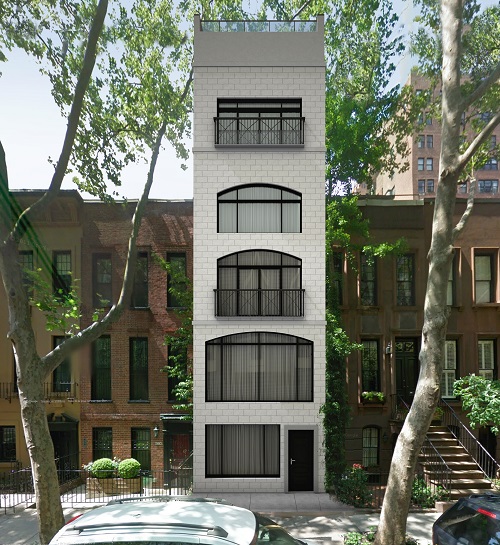
Upper East Side Rowhouse Growth Spurt

When does a coherent row of brownstones become a miscellany of masonry? That point is nearing or even past for the rowhouses on the south side of East 69th Street, from Second to First Avenues. Thirty years ago they were a nearly uniform group of charming dwellings. Now the string has broken, and these little pearls are skittering across the floor.
Not many blocks east of Third Avenue saw sustained rowhouse development, but for some reason in the late 1870s the developer James E. Ray favored this block with a particularly expansive row of 30 houses. He built the houses closer to Second, Nos. 310-344, three stories tall with a high stoop; for those closer to First, Nos. 346-368, he stopped at two stories and a stoop. Ray worked with several architects, and the variations are modest. But in the 20th century, the sweep of the row, especially the two-story models, was striking.
Ads for the houses began running in early 1880, when The New York Times offered No. 340 for rent for $65 per month. The 1880 census indicates that perhaps half the original residents were born abroad, with nativity noted as Germany, Austria, Bavaria, Prussia, Bremen and so on.

The number of residents in 19th-century rowhouses was far higher than we expect today. Henry Stadler, a gas fitter from Hesse, lived in the two-story house at 368 East 69th with nine family members and a boarder.
Even new houses were not always occupied as we might suppose: In 1883 The Herald offered the “Upper Part of First Class private house” at No. 334 with “private bathroom,” and in 1888 the same paper indicated that individual rooms at No. 324 were available, including the “magnificent” back parlor for $30 a month.
Each house enclosed dreams and hopes. In 1883 The Herald carried an ad from a “north German young lady” employed at 324 East 69th, who sought work as a governess and was “perfect in music, German and fancy needlework.”
Another East 69th Street striver identified himself in The Times in 1912 as “M. Heib” and announced: “Young Man wishes position as cook; understands French, Hungarian, German cooking; first class pastry man; speaks French, German, Hungarian; understands English.” Mr. Heib lived at No. 366, apparently as a boarder.
Hungarians, Czechs and other Central Europeans were increasing in the neighborhood and in 1915 the Hungarian Reformed Church of New York retained the architect Emery Roth to design its towered Secessionist-style church at 346 East 69th Street. The Herald described East 72nd Street as “the gateway to the Hungarian section in New York.”
After the church went up, change occurred in modest increments. A few owners de-stooped their houses, and Modernism arrived in 1960 when the builder Herman Axelrod gutted the front of 364 East 69th, replacing the old brownstone facade with plate glass and open balconies.
Another radical reconstruction occurred sometime after 1983, when 320 East 69th Street got a French provincial makeover. And at some point, the upper section of 310 East 69th Street received a clunky balcony, suggesting a need to pour boiling oil on unwanted guests.
Around this time the block association briefly consulted with me, and with Andrew S. Dolkart, about securing landmark designation for the block from the Landmarks Preservation Commission, but the idea was voted down. The architect William B. Gleckman owned No. 312, at the time nearly perfectly intact, and he objected to the proposal, dismissing the houses as having been built “for a very bourgeois public.”
A subsequent owner stripped off the old brownstone facing around 2010 and replaced it with an awkward full-height window bay. However, the building is still the same height as the flanking houses.
The other end of the block is in renovation ferment. Recently the firmDesign AIDD gave two-story-high 368 East 69th Street a glass box enclosure and a three-floor addition. That’s enough to make Mr. Axelrod’s 1960 facade look positively antique, but change is also coming to two-story 358 East 69th: an austere five-story high masonry facade with broad windows. It is built to sell; Thomas Wexler at the Corcoran Group is the broker; interior and exterior views may be found on the Corcoran website.
The townhouse is for sale for $7.5 million and Mr. Wexler said the reason the project went this way was simply “space — it doubles it”; the regular two-story houses with walk-out basements trade in the $3.5 million range. The reimagined No. 358 has a pool, an elevator, a wine cellar and will “fulfill your wildest dreams in unsurpassed luxury,” according to the Corcoran listing.
Mr. Wexler says that No. 358 is just the first — 360 and 362 East 69th Street are going to be rebuilt along the same lines. A final judgment of how the charm of the 21st century will stack up against that of the 19th will have to wait another year or so, when all three are completed.